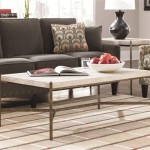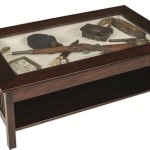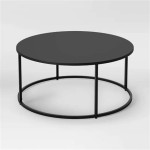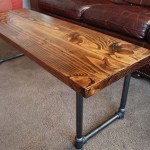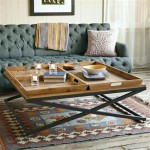Ideas to Transform Your Coffee Table with Painting
The coffee table, often relegated to the center of the living room, serves as more than just a surface for drinks and magazines. It is a focal point, silently contributing to the overall aesthetic of the space. A well-chosen and thoughtfully decorated coffee table can elevate the room's design, reflecting personal style and enhancing the atmosphere. For individuals seeking a cost-effective and impactful way to refresh their living space, painting presents an excellent solution. The application of paint can dramatically alter the appearance of a coffee table, turning a tired piece into a statement item or seamlessly blending it into a newly designed interior.
This article explores a range of painting techniques and design ideas applicable to coffee tables. It delves into surface preparation, paint selection, and creative application methods, offering practical guidance for transforming a coffee table into a personalized art piece.
Surface Preparation: The Foundation for a Flawless Finish
Before applying any paint, proper surface preparation is crucial. The success of the paint application and the longevity of the finished product hinge upon a clean, smooth, and properly primed surface. The initial step involves cleaning the coffee table thoroughly. This typically entails removing any dirt, dust, grease, or existing finishes that might impede paint adhesion. A mild soap and water solution is often sufficient for routine cleaning; however, for surfaces with stubborn residue, a specialized degreaser may be necessary.
Following the cleaning process, sanding is essential. The purpose of sanding is to create a slightly rough texture, known as a "tooth," which allows the paint to grip the surface effectively. The appropriate grit of sandpaper depends on the condition of the existing finish. For relatively smooth surfaces, a fine-grit sandpaper (around 220 grit) is suitable. However, if the coffee table has a glossy varnish or a heavily textured surface, a medium-grit sandpaper (around 120 grit) may be required to break down the existing finish. When sanding, it is important to sand evenly and consistently, paying particular attention to edges and corners. After sanding, all sanding dust must be meticulously removed with a tack cloth or a damp cloth to ensure a clean surface for painting.
Priming is the final, and arguably most important, step in surface preparation. Primer acts as a bonding agent, creating a uniform surface for the paint to adhere to. It also helps to seal the surface, preventing paint from being absorbed unevenly and ensuring a consistent color throughout. The type of primer to use depends on the material of the coffee table. For wood coffee tables, a wood primer is recommended. For metal coffee tables, a metal primer is necessary to prevent rust. For laminate surfaces, a specialized bonding primer is essential to ensure paint adhesion. The primer should be applied in thin, even coats, following the manufacturer's instructions. Typically, one or two coats of primer are sufficient, allowing each coat to dry thoroughly before applying the next.
Paint Selection: Choosing the Right Medium for Your Vision
The selection of paint is paramount in achieving the desired aesthetic and ensuring the durability of the painted coffee table. A wide range of paint types are available, each with its own unique properties and advantages. The choice should be guided by factors such as the desired finish (matte, satin, gloss), the material of the coffee table, and the level of durability required.
Acrylic paint is a popular choice for furniture painting due to its versatility, ease of use, and water-based composition. Acrylic paints are available in a wide range of colors and finishes, and they dry relatively quickly. They offer good adhesion to most surfaces and are relatively durable, making them suitable for coffee tables that experience moderate use. Acrylic paints are also low in VOCs (volatile organic compounds), making them a more environmentally friendly option.
Latex paint, another water-based option, is often used for interior walls but can also be applied to furniture. Latex paints are known for their durability and ease of cleaning. They offer good coverage and are available in a wide range of colors and finishes. Latex paints are also relatively low in VOCs. However, latex paints may require a primer specifically designed for furniture to ensure proper adhesion.
Oil-based paints, while less commonly used for furniture painting due to their longer drying time and higher VOC content, offer exceptional durability and a rich, lustrous finish. Oil-based paints are particularly resistant to scratches and scuffs, making them a good choice for high-traffic areas. However, the use of oil-based paints requires proper ventilation and the use of appropriate safety equipment due to the presence of VOCs. Oil-based paints also require more specialized cleaning solvents.
Specialty paints, such as chalk paint and milk paint, offer unique aesthetic qualities. Chalk paint creates a matte, vintage-inspired finish that is easily distressed. Milk paint, a traditional paint made from milk protein, lime, and pigment, produces a similar matte finish and can be used to create a variety of decorative effects. Both chalk paint and milk paint typically require a sealant or wax to protect the finish.
Beyond the type of paint, the chosen color palette plays a crucial role in the overall transformation of the coffee table. Colors can be used to create a variety of effects, from blending the coffee table seamlessly into the existing décor to making it a bold statement piece. Neutral colors, such as white, gray, and beige, offer versatility and can complement a wide range of interior styles. Bold colors, such as blue, green, and red, can add a pop of visual interest to the room. It is important to consider the existing color scheme of the living room when selecting paint colors for the coffee table.
Creative Application Techniques: Unleashing Artistic Potential
Once the surface is prepared and the paint is selected, the application process begins. The application technique can significantly impact the final appearance of the coffee table. There are numerous techniques that can be employed, ranging from simple solid color applications to more complex decorative finishes.
A solid color application is the simplest and most straightforward technique. This involves applying one or more coats of paint in a uniform color to the entire surface of the coffee table. This technique is ideal for creating a clean, modern look or for blending the coffee table into the existing décor. When applying a solid color, it is important to use smooth, even strokes and to avoid applying the paint too thickly, as this can lead to drips and runs. Multiple thin coats are preferable to one thick coat.
Two-tone painting involves using two different colors to create visual interest. This technique can be used in a variety of ways. For example, the legs of the coffee table can be painted in one color, while the tabletop is painted in another. Alternatively, a two-tone effect can be achieved by painting the entire coffee table in one color and then adding accents or details in a contrasting color. Two-tone painting can be used to create a more playful or sophisticated look, depending on the colors chosen.
Stenciling allows for the addition of intricate patterns and designs to the coffee table. Stencils can be purchased pre-made or created using online templates and a cutting machine. To use a stencil, it must be carefully positioned on the surface of the coffee table and secured with painter's tape. Paint is then applied to the stencil using a stencil brush or a sponge. It is important to use a small amount of paint and to blot the brush or sponge before applying it to the stencil to prevent the paint from bleeding underneath the edges. Stenciling can be used to add a touch of elegance, whimsy, or personality to the coffee table.
Distressing creates a worn, vintage look by intentionally removing some of the paint to reveal the underlying layers or the raw wood. This can be achieved using sandpaper, steel wool, or a variety of other tools. Distressing is typically done after the paint has dried completely. Areas that are naturally subject to wear and tear, such as edges and corners, are typically distressed more heavily. Distressing can add character and charm to a coffee table, making it look like a treasured antique.
Adding a protective topcoat is a crucial final step in the painting process. A topcoat provides a layer of protection against scratches, scuffs, and spills, ensuring the longevity of the painted finish. Polyurethane is a popular choice for furniture topcoats due to its durability and resistance to water and chemicals. Polyacrylic is a water-based alternative that offers similar protection and is lower in VOCs. Wax can also be used as a topcoat, providing a soft, matte finish. The choice of topcoat depends on the desired level of durability and the aesthetic preference.

How To Transform Your Coffee Table Into A Rustic Industrial Masterpiece Wood Makeover Painted Tables Redo

22 Clever Ways To Repurpose Furniture Painted Coffee Tables Diy

Diy World Market Coffee Table Makeover Liz Marie Blog

26 Stunning Hand Painting Tables To Transform Your Space Onelmon

Refinished Coffee Table Delicious And Diy

Transform Your Mission Style Coffee Table Easy And Affordable Diy

17 Diy Coffee Table Ideas To Transform Your Living Space Hometalk

Coffee Table Makeover Delicious And Diy

Coffee Table Makeover Hawthorne And Main

Coffee Table Makeover Delicious And Diy
Related Posts



